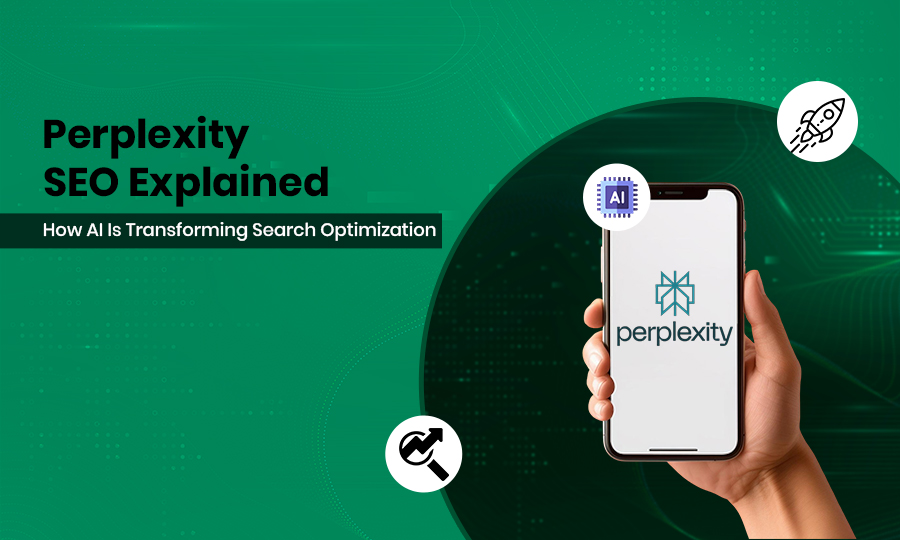In today’s evolving search landscape, relying only on traditional search engine optimization (SEO) is not enough. It makes you stay behind your competitors. So, what do you need to do? Well, you need to focus on AI search engine optimization – Perplexity SEO is one of them.
The main reason is that the AI SEO market is growing by leaps and bounds, and it will continue to surge even in the coming times as well. According to Search Engine Land, approximately 85.7% of businesses are already spending on AI SEO, and 61.2% are planning to spend more on this.
The above stats clearly envisage businesses of late quickly adopting AI search engine practices to make their appearance in Google’s AI-curated overview. If we talk about Perplexity SEO, it’s an important and emerging concept in the realm of search optimization. It allows you to earn context, citation, credibility, etc. for your brand within AI-generated answers.
When you adopt this SEO, it improves your ranking while projecting you as one of the trusted sources that AI refers to. If you master this practice as soon as possible, it helps you gain an unmatched brand authority with improved visibility in an AI-focused search ecosystem.
What is Perplexity SEO?
Perplexity SEO is a process that includes the required practices to optimize website content with a complete understanding of how search engines interpret relevance and complexity. It indicates the optimization of content for an AI-powered search engine, with the core objective of creating content as a primary source for Perplexity’s answers. It also ensures your website gets featured as a reference.
Perplexity SEO includes a range of activities that are as follows:
- Keyword and intent research
- Create human-written content that directly answers the questions of users, including follow up questions.
- Technical and semantic optimization
- Update and make fresh content
- Build topical authority
- Analyzing brand visibility in Perplexity
Perplexity SEO plays a vital role in performing numerous tasks, such as improving topical authority, enhancing search rankings, and ensuring content that reflects both search engine algorithms and users.
How Perplexity AI Works
Being a robust AI-driven search and question-answering engine, Perplexity AI blends real-time web data with large language models (LLMs) to provide users contextual and accurate answers. Compared to traditional search engines that include various results, Perplexity AI synthesizes mainly information from valid online sources. It offers well-structured and concise responses. Let’s understand in more detail how Perplexity AI works:
- Perplexity AI leverages transformer-based models, which are exactly the same as the GPT architecture of OpenAI. It’s indeed useful to understand natural language queries.
- It has an enormous capability of processing input by breaking it down completely into tokens, producing coherent answers, and interpreting context with the use of attention mechanisms, which tend to mimic human reasoning.
- It implements a retrieval-augmented generation (RAG) framework, which enables it to pull the most appropriate and updated details from the web before creating a final response.
- Perplexity AI follows the process of learning through user interactions, which redefine phrasing, intent, topic relevance, etc.
- The great combination of contextual comprehension, real-time retrieval, adaptive learning, etc., ensures it works both as a conversational AI and also a search assistant. It indeed delivers more precise and faster information discovery, which minimizes the overall gap between intelligent dialogue systems and conventional search engines.
Why Perplexity SEO Matters for Brands?
Perplexity SEO matters a lot for any business for several reasons. The following are some of the top reasons with detailed descriptions:
- AI-driven Search Assistants
Perplexity AI plays an indispensable role in how users gather and use information. Therefore, it’s quite essential for any business to adapt its SEO strategies as well to stay credible and visible in today’s emerging landscape. You need to take into account that Perplexity not only indexes your website but it also interprets well-written content contextually, citation-based answers, presents summarized results, and more.
This is indeed a great shift that reflects how businesses optimize for Perplexity SEO, which helps them position themselves as authoritative sources in various AI-based results. It creates robust opportunities for organizations to boost trust and brand awareness.
- Builds Brand Credibility
When your website content gets cited by Perplexity AI, it reflects your well-written content as a reliable source and thus indicates to users and search algorithms. It also indicates your brand information is well-structured and reliable. When your web page is visible in the AI-curated citations, it improves the reputation of the brand for authority and expertise in its industry.
- Opportunity to Appear in Cited Sources
Be it factual accuracy, clarity, or semantic relevance, Perplexity SEO offers everything. When your brands create well-researched, top-quality, and easy to interoperable content, you get a higher possibility of being referenced directly in AI-driven responses. It helps users gain full exposure even without top SERP rankings.
- Early Adopters can Gain Visibility
You must know that AI-powered assistants are still in the growing phase. So, those who adopt early can gain a significant edge. It’s really important for brands to understand the way of optimizing for Perplexity AI with the use of NLP-optimized content, structured data, topic authority, and more. These indeed capture a great visibility before space becomes highly saturated.
Perplexity SEO vs ChatGPT SEO vs Google SEO: A Comparative Analysis
So, you may be seeking to know how Perplexity SEO is different from traditional SEO, right? Let’s go through a detailed comparison to understand it better:
| Factors | Perplexity SEO | ChatGPT SEO | Google SEO |
| Function | Being an AI-driven search assistant, it provides cited and concise answers from live web data. | It’s basically a conversational AI that produces responses from those of pre-trained data. | It involves indexing and ranking websites based on algorithms. |
| Data Source | It relies mainly on credible citation and real-time web retrieval. | It’s trained mainly on historical dataset, which is limited mainly to its last updated knowledge. | It indexes mainly web pages crawled and ranked through algorithms. |
| Search Intent Handling | It ensures interpretation of user queries semantically with the use of natural language processing, machine learning, and also delivers context-rich and summarized answers. | ChatGPT mainly understands that context but also trends to produce or also outdated content. | It involves matching keywords and also intent on snippets and ranked pages. |
| Focus on Content Optimization | Factual accuracy, clarity, structured data, and semantic relevance. | It involves content optimization through natural phrasing, conversational tone, informational completeness, etc. | It involves backlinks, keyword optimization, Core Web Vitals, mobile-friendliness, etc. |
| Visibility Opportunity | It involves being visible as a cited-source in AI-produced answers. | Being integrated or referenced into AI-driven text. | It helps websites rank high in SERPs through on-page and off-page SEO. |
| User Experience | It improves user experience through summarized and direct responses with linked citations. | It offers interactive conversational experience. | It improves user’s search experience through list-based outcomes needed manual exploring. |
| Monetization | It involves focusing on visibility and authority through citation. It doesn’t refer any direct traffic. | It has less traffic generation potential. | It provides direct website traffic with the help of clicks on the ranked results. |
Important Strategies to Optimize for Perplexity SEO
If you wish to make a presence of your business website in the citation of Perplexity AI or recommended by it, you should optimize it with a proper strategy. Let’s discuss some of the top strategies you can consider to implement:
- Focus on User Search Queries
While talking about Perplexity SEO strategies, it’s important to start with keyword research. You may be aware of the fact that traditional SEO mainly emphasizes short yet high-volume keywords.
Meanwhile, Perplexity SEO only values long-tail, conversational, and natural queries. So, you need to focus on what users speak or type with the use of AI assistants’ questions.
For instance, if you wish to target “AI tools”, you should use queries like “top AI tools for businesses. You can use queries like “What are the ways to use AI tools for email marketing?”. Since Perplexity is based mainly on context, optimization for detailed and specific queries lets your human-written content match real user intent.
To find the right user queries, you can use the following important tools:
- AlsoAsked
- AnswerThePublic
- People Also Ask (by Google)
Leveraging the above tools helps you find the relevant question-based queries that Perplexity seeks to surface.
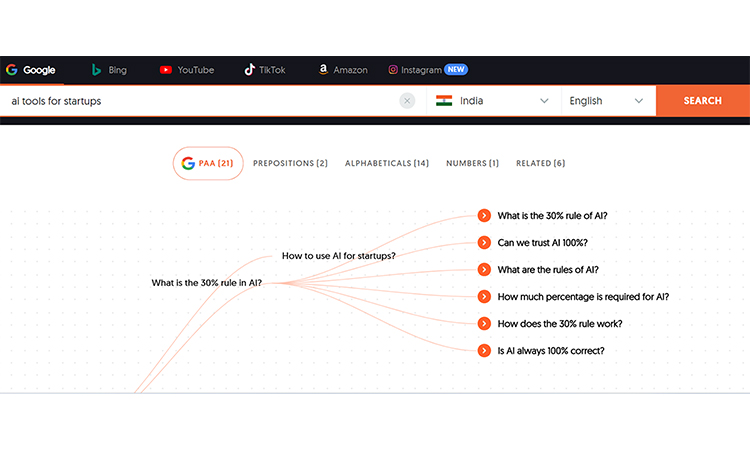
- Focus on What Users Look
You need to take into account that Perplexity AI not only matches keywords but also helps you understand user intent better. It reflects that your content should also go beyond surface-level information and answer “how” and “why” even behind a search query.
We can take an example, when users search “what are ways to optimize AI search engines,” they are likely seeking actionable strategies as well, rather than only a definition. Make sure your high-quality content fulfills the following criteria:
- You should follow up with certain examples, details, practical steps, etc.
- Make sure you start with a clear and direct answer.
- You can access the related questions naturally, even within the text.
For instance, you can use Perplexity SEO to help your website be visible in AI-produced answers, rather than “Perplexity SEO enables you to get visibility. It’s indeed the same in terms of how feature snippets work on Google, but with a powerful emphasis on authority and trust.
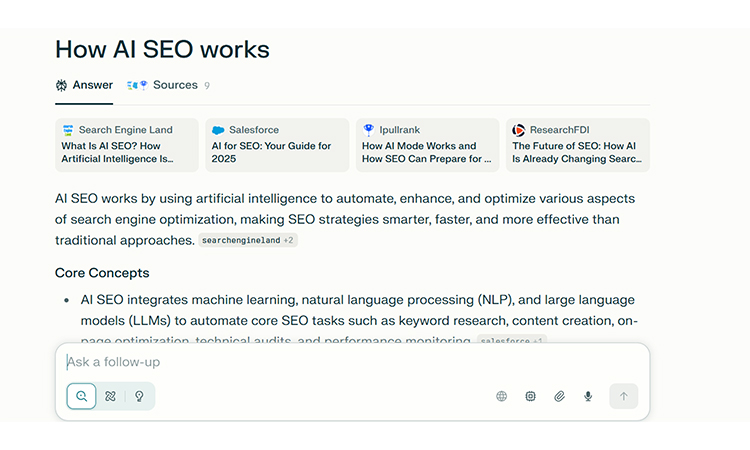
- Craft Research-Based Content
You need to be aware of the fact that Perplexity focuses on trustworthy, well-researched, insightful content, and more. Generic blogs will certainly not reduce it anymore; you need to ensure that your articles need to reflect data, evidence, expertise, etc.
You can do it by keeping the following things in mind:
- It’s advisable to include case studies. For instance, you can provide details about how your company increased traffic with the use of AI-driven search engine optimization.
- You need to write comparison-based posts, such as Perplexity AI vs Traditional SEO.
- Make sure you keep your tone highly conversational yet data-driven.
- You also need to integrate user intent keywords in natural ways. For instance, you can include several ways like “Why does”, “How to”, “What is the right way to”.
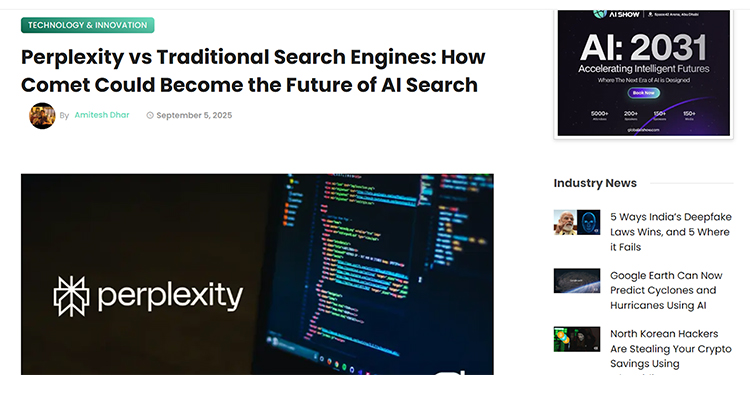
In the above image, we mention the complete details of Perplexity vs Traditional search engines. It helps you understand which has an edge over others.
- Focus on Content Structure and Update Old Content
One thing you need to take into account is that even your best information tends to go undiscovered or unnoticed if you don’t focus much on its structure. Always remember, Perplexity AI has the capability to scan for readable and clear hierarchy sections since it helps models cite or summarize your content with higher accuracy.
How to Structure Your Content?
Well, you can structure your content in various ways. Some of them are as follows:
- Add Frequently Asked Questions (FAQs)
- For more clarity, you can add bullet points.
- You can use H2/H3 subheadings to break content into different digestible parts.
- Update your old posts on a regular basis with citations and fresh data.
- Implement lists, tables, schema markup, etc.
For instance, if you have already written a blog on “SEO Trends in 2024”, you need to update it by making it in recent years. Make sure you include the latest stats to update and thus make it more relevant.
For instance, Backlinko is one of the popular websites that continuously updates its blog. It doesn’t mention the year in its main title, but it includes the body. It also works effectively in increasing visitors to websites.
- Build Your Presence on High-Authority Websites and Earn Backlinks
When it comes to source authority, it’s something that plays a vital role in Perplexity’s credibility. Websites cited mainly reputable platforms such as HubSpot, Forbes, TechCrunch, and more have the potential to be visible in answers generated by Perplexity.
So, now the question is, how to get credibility? Well, you can do it in various ways. Let’s find some of them as follows:
- Develop quotes or partnerships with experts from niche areas.
- Be visible in industry interviews and roundups.
- Contribute effectively in high-authority publications and guest posts.
- Leverage important tools like HARO to get organic mentions.
If Perplexity AI cites any article from Search Engine Journal that mentions your brand, you gain exposure indirectly as a reliable information source.

In the above image, we have asked Perplexity AI about “AI SEO Trends in 2025”. You can already visualize the cited sources (Salesforce and others) in the answer.
- Create a Topical Authority
You should be familiar with the fact that Perplexity gives preferences to experts. When your website covers a particular niche consistently, it will appear as a topical authority. We have provided several tips and tricks to create the authority:
- Create pillar pages that summarize several important subtopics.
- You need to build a cluster of various interlinked articles on the same kind of subject.
- Make sure consistency of depth and tone across various posts.
- You need to post data-based reports or original and practical insights.
If your website has a page titled “AI SEO Strategies” and also supports blogs such as “How ChatGPT impacts SEO, or AI-based Keyword Tools, your website gets a higher chance to be recognized as a reliable AI SEO resource.
- Build Your Presence in Social Media and Online Communities
One thing you should always keep in mind is that social signals never directly affect traditional SEO rankings. Meanwhile, for Perplexity SEO, online presence has a great relationship with trust. Perplexity quite often references insights from LinkedIn, X, Reddit, and more, especially when experts share scenario-based discussions or important opinions.
How to Leverage the Power of Social Media?
Well, you can try the following important practices to harness the maximum potential of social media. Let’s understand some of the proven tips:
- It’s advisable to share research snippets and micro-insights on LinkedIn.
- You need to collaborate with influencers in your niche.
- Participate actively in niche-based communities, including Quora and Reddit.
- You should engage actively to avoid spammy self-promotion.
We will discuss here an example of healthcare experts sharing about “5 Strategies for Implementing an AI Chatbot in Healthcare” on LinkedIn. It tends to be cited, especially when Perplexity users ask.
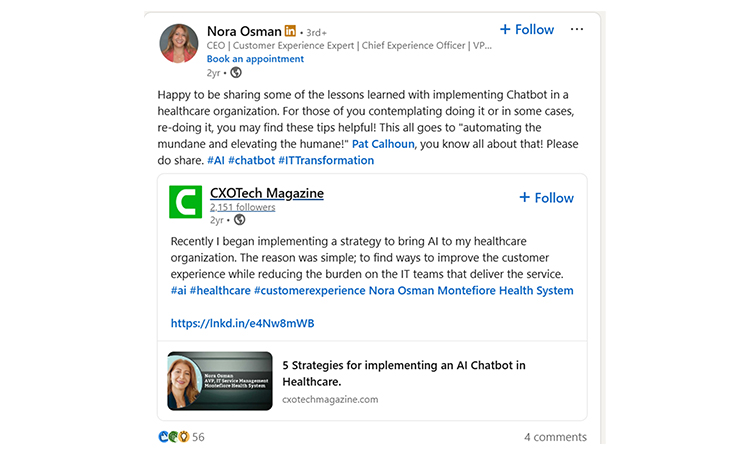
- Add Internal Links
It’s quite essential to keep in mind that internal linking is not only an important trick. It’s also a popular context builder when it comes to Perplexity. You need to know that internal links have a greater influence on AI models. It helps them understand how topics on your website are related to one another. It also helps them map your expertise perfectly.
How to Add Internal Links?
You can consider the following important tips to add internal links to your web pages:
- You need to link only those related articles in a natural way, and also within the text.
- Make sure you use descriptive anchor text. For instance, rather than using “click here”, you can use “explore how to optimize for AI search engines”.
- Make sure your navigation structure is intuitive and simple.
In the image below, the internal link inserted seems quite natural and appropriate based on the blog.
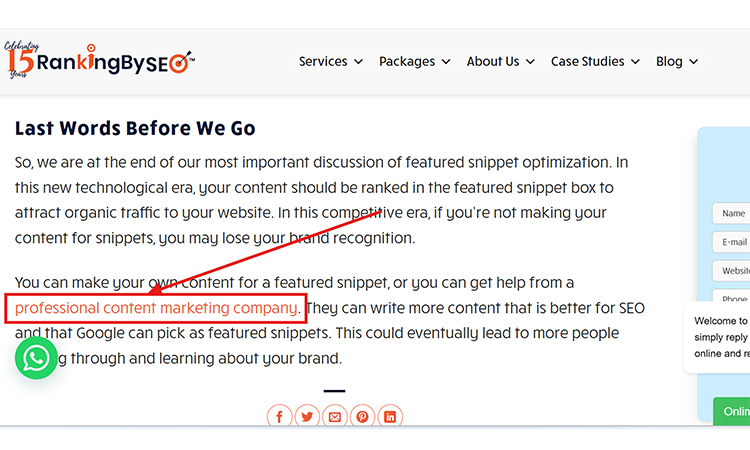
- Always Use Valuable Insights and Expert Quotes
For Perplexity, only that content is useful that includes the verified insights and expert authority. When you add statistics, quotes, references, etc., to thought leaders, it boosts credibility and also encourages models to cite you.
How to Implement it Better?
To implement it perfectly, you can consider the following important tips:
- Make sure you include an expert quote. When you include stats, you should include the name of the source. For instance, we take stats from a valid source about the SEO market size and will write as “According to Research and Markets, the SEO services market size is projected to grow $92.74 billion in 2025 from $79.45 billion in 2024.
- The next important thing you can do is to include only the latest stats, whitepapers, reports, government data, etc.
- Once you provide insights, you need to include only practical takeaways.
In the above image, you can already see. Stats are published with the source name.
Some Common Mistakes to Avoid for Perplexity SEO
While doing Perplexity SEO, a large number of professionals commit several mistakes as well. You need to avoid those mistakes to get the best outcomes:
- Keyword Stuffing Without Context
Keyword stuffing is something that is prohibited, whether it’s traditional or Perplexity SEO. If you keep using keywords in your content without adding value to your readers, it may even confuse AI models as well. On the other hand, it also minimizes readability.
Solutions: You should always focus on storytelling rather than overusing keywords and related phrases.
- Improper Structure
A proper content structure is necessary to get cited by Perplexity. It’s also useful in summarizing or extracting important answers. If your article doesn’t have proper bullet points, headings, logical flow, etc., the model tends to face difficulty in interpretation.
Solution: It’s advisable to use H1, H2, H3………content structure. Make sure your content is easy to read, whether it’s for AI or human readers.
- Incomplete Content
Using incomplete content will not provide the desired outcomes. The actual reason is that Perplexity prefers informative, comprehensive, multi-angle responses, etc. For example, when you write about the topic “Perplexity SEO strategies, you should describe much more than just a definition.
Solution: Make sure your content is complete. It’s good to include examples, use cases, statistics, etc.
- Ignore Reliable Sources or Citations
Perplexity often values cited and trustworthy information. Therefore, when you fail to reference industry experts, credible sources, or any real-world examples, it adversely impacts your authority.
Tools to Track Perplexity SEO
You need to use reliable tools to track the performance of Perplexity AI with higher accuracy. The following are some of the reliable tools you can leverage to gather the desired outcomes:
- Perplexity Search Tracking Tools
With the continuous emergence of Perplexity AI, many third-party tools have gained huge prominence. Some of them are as follows:
- Rankify AI
- PerplexityRank
- PerplexityLabs
These are some of the top tools you can consider to leverage to analyze citation frequency, query visibility, snippet placements, and more across the summary or answers provided by Perplexity.
Tips to Use the Tools
- You need to first enter either your blog or brand URLs.
- Always check how frequently your website is mentioned under certain queries.
- Check which topics or keywords improve AI citations.
- LLM Monitoring Extensions and Traditional Analytics
When it comes to LLM monitoring, you get various options to use. Some of the popular ones are as follows:
- Longsmith LLM Observability
- Portkey
- Helicone
- Trulens
- Traceloop OpenLLMetry
They help you observe websites cited by Perplexity. It’s vital to combine these important insights with Ahrefs, Google Analytics, and more. These indeed help you to track keyword growth, referral traffic, etc.
How to Use These Tools?
Well, almost every tool is available with an extension. You need to install the extension of the tool that you think is the best. Once you install the extension successfully, you will be able to observe pages that are cited or appear. It’s also advisable to do a cross-check by using Ahrefs or others to visualize the exact correlation.
- Mention Monitoring and AI Citation Tracking
The next important tools you need to leverage are for AI citation tracking and mention monitoring. While searching for these tools, you will come across plenty of options. Some of the popular ones are as follows:
- OtterlyAI
- Peec AI
- Profound
- Sprout Social
- Mention
- Talk Walker
- Semrush AIO
How to Use These Tools?
To use them in the most effective way, you can set alerts for your blog titles, brand name, etc. When you notice any AI tools cite your website, you will get an instant notification.
Future of Perplexity SEO
As far as the future of Perplexity SEO is concerned, it seems to focus more on credibility, context, user relevance, etc., rather than keywords. Let’s find out in detail:
- AI-Based Content Curation
AI-based content curation is something that Perplexity seems to rely extensively on in the coming time. In this, only factual, top-quality, and multi-source information often gets cited. It will not only reflect one answer. Instead, it synthesizes various expert perspectives into an individual summary.
For instance, when we type a question like “Why AI SEO is Important for Businesses”. It curates multiple sources to summarize the best answer. You can go through the following image to understand it better.

- AI Search Ecosystem
In the future, it’s expected that the AI search ecosystem will be broader, where Perplexity integrated perfectly with cutting-edge tools such as Bing Copilot, ChatGPT, Google’s Gemini, and more for cross-platform knowledge sharing. With the use of these tools, you can make the right and future-proof AI SEO strategies.
It’s necessary for marketers to optimize content while ensuring its interoperability with AI visibility. It ensures universal recognition of structure, metadata, expertise, and more.
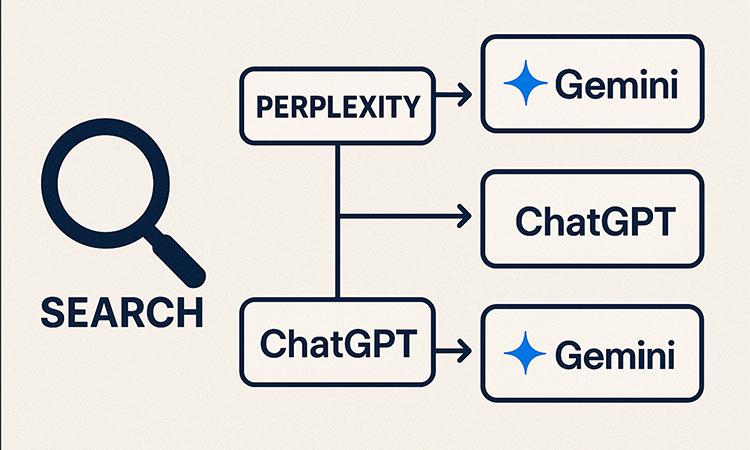
- Voice Interface
With the increasing popularity of voice search, AI assistants also seem to be voice-first. Perplexity SEO tends to align perfectly with speech-friendly and conversational content. You can ask a question to Perplexity: What are the top eco-friendly packaging startups? And you will observe AI tends to cite a highly relevant and verbal-ready response.
- Search Personalization
Perplexity is set to offer more personalized results in the coming time. It will provide the best answer based on understanding user preferences, behavior, tone of queries, and more. You need to understand that businesses that tailor content for any specific search contexts or personas will indeed dominate the visibility.
Wrap Up
You need to understand that Perplexity SEO is not only about passing trends; it’s indeed the next big shift when it comes to digital visibility. Since AI-based search assistants seem to transform how users gather and trust information, you should adapt early to gain a competitive edge. It’s highly important to emphasize structure, context, authority, and more. These help you position yourself to be trusted and cited by AI models. Partnering with a professionals AI SEO company lets you understand and harness the actual potential of Perplexity SEO.

